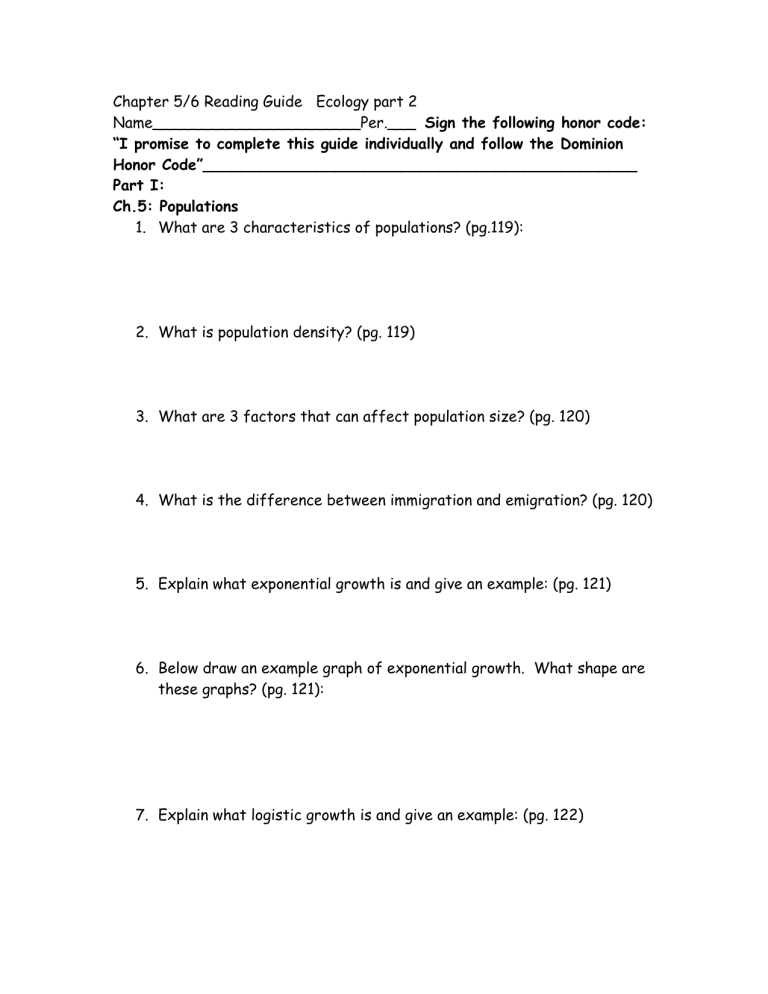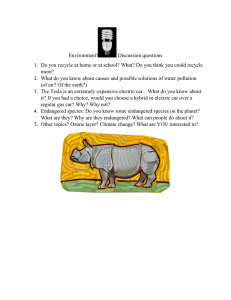Chapter 5/6 Reading Guide Ecology part 2 Honor Code”______________________________________________

Chapter 5/6 Reading Guide Ecology part 2
Name______________________Per.___ Sign the following honor code:
“I promise to complete this guide individually and follow the Dominion
Honor Code”______________________________________________
Part I:
Ch.5: Populations
1.
What are 3 characteristics of populations? (pg.119):
2.
What is population density? (pg. 119)
3.
What are 3 factors that can affect population size? (pg. 120)
4.
What is the difference between immigration and emigration? (pg. 120)
5.
Explain what exponential growth is and give an example: (pg. 121)
6.
Below draw an example graph of exponential growth. What shape are these graphs? (pg. 121):
7.
Explain what logistic growth is and give an example: (pg. 122)
8.
Below draw an example graph of logistic growth. What shape are these graphs? (Pg.122)
9.
Explain what is meant by carrying capacity. (pg. 122)
10.
Explain what a limiting factor is (pg. 124)
11.
What is a density-dependent limiting factor? (pg. 125)
12.
Give some examples of density-dependent limiting factors: (pg. 125)
13.
What type of competition is a major force behind evolutionary changes? (pg. 125)
14.
Explain what a typical predator-prey relationship is (pg. 126):
15.
Explain the graph of the wolves and moose on pg. 126:
16.
What is a density-independent limiting factor? (pg. 127)
17.
Give some examples of density-independent limiting factors: (pg. 127)
18.
The human population is well on its way to reaching what number within your lifetime? (pg. 129)
19.
Look at the age-structure graph on pg. 131. How do the U.S. and
Rwanda differ in the percentages of 10-14 year olds in the population?
Ch.6-Humans in the Biosphere
20.
What did the arrival of the Europeans do to the Islands of Hawaii?
(pg. 139):
21.
Why is the Earth also like an island? (pg. 139)
22.
What are some human activities that have transformed the biosphere? (pg. 140)
23.
Describe what happened during the Green Revolution. (pg. 142):
24.
What has been the affect of Industrial Growth and Urban
Development on the environment? Name 3 results: (pg. 143)
25.
What is the difference between a renewable and a nonrenewable resource? (pg. 144)
26.
What is meant by the “Tragedy of the Commons” (pg. 144)
27.
What is sustainable use? (pg. 145)
28.
Give an example of sustainable use (pg. 145):
29.
What is soil erosion: (pg. 145)
30.
What is desertification? (pg. 145)
31.
What is deforestation? (pg. 146)
32.
What can deforestation lead to? (pg. 146)
33, Define smog. (pg.148)
33.
Define pollutant: (pg. 148)
34.
What can the burning of fossil fuels do? (pg. 148)
35.What is the cause of acid rain? (pg. 148)
36.
What are some effects of acid rain? (pg. 148)
37.
Although water is considered a renewable resource, the total supply is what? (pg. 149)
38.
List two human activities that can affect water resources (pg. 149):
39.
Define biodiversity (pg. 150):
40.
Why is preserving biodiversity important? (pg. 150)
41.
How can human activity reduce biodiversity? (pg. 151)
42.
What is the difference between extinction and endangered? (pg. 151)
43.
What is the result of habitat fragmentation? (pg. 151)
44.
What does CITES stand for and what does it do? (pg. 151)
45.
Using the history of DDT, explain what happens during biological magnification (pg. 152):
46.
What is an invasive species? (pg. 153)
47.
Why can they cause ecological problems? (pg. 153)
48.
What happened with the zebra mussels? (pg. 153)
49.
Today what do conservation efforts focus on? (pg. 154)
50.
What do conservation biologists mean by a “hot spot” (pg. 155)
Part II. Select an endangered species from the list (no two students in a class may select the same species! You can also use an organism that is not on the list, if it is endangered. Conduct some research and create a fact sheet using the following rubric as your guide. No cut and paste!
Grading Rubric for Endangered Species
1. Scientific name and full classification (Kingdom, Phylum, Class,
Order, Family, Genus, species) and any closely related species if possible ______/2 pts.
2. Physical features: diet, adaptations, reproduction, etc. , include photograph or sketch _____/2 pts.
3.
Habitat-describe the organism’s habitat and where in the world it is found ____/1 pt.
4. Why is it endangered?: is it due to Habitat loss, toxins, pollutants, disease, hunting, or genetic issues? _____/ 1 pt.
5. What conservation efforts are underway? What is being done to save the species? Are the efforts working? ___/2 pts.
6. What is the present-day world wild population size? How many are left? ____/1 pt.
7. Explain what the Endangered Species Act of 1973 is, and when do we call a species endangered versus threatened. ____/1 pt.
8. List the sources you used for this information: (you will not receive any points,unless you list your sources).!!!!
_______________________________________________
_______________________________________________
_______________________________________________
_______________________________________________
_______________________________________________




